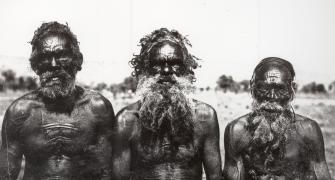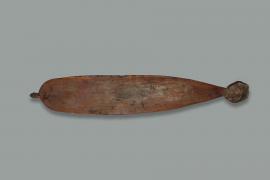There is growing evidence that they were here before that, and some believe it is possible that they arrived as far back as c.120,000 years ago which is the next point in the history of the region that the sea levels would have been low enough for a voyage to our continent to have been possible. Even though sea levels then were much lower than today, a substantial sea crossing would still have been required 1 2 3
Upon reaching Australia, Aboriginal people quickly spread throughout the continent and over time they established substantial trade and ceremonial routes. For example, stone edge-ground axes have been found throughout northern Australian archaeological sites extending over a 30,000 year period 4. During the Holocene epoch (which is the current epoch that started around 11,500 years ago) and up until the arrival of Europeans disrupted these trade networks, production and trade of axes became a major occupation. A site at Mt Isa in Queensland is known to be the source of the stone used to produce many axes which were traded over much of central, eastern and northern Australia, including the Lake Eyre Basin 6 as well as into Cape York 7 8.
The climate of the West MacDonnell Ranges has been more or less arid throughout the last 50,000 years 9 and while this might lead you to think that it would not have been occupied by people in the past, there is good evidence that the region has been occupied for at least the past 30,000 years 10. The ability of Aboriginal ancestors to adapt to different environmental conditions has long fascinated researchers and is a testament to the adaptive technologies and practices that Aboriginal people such as the Arrarnta adopted.
Trade and exchange of stone tools amongst Aboriginal people
In the mid-Holocene, marked changes in archaeological remains occur, including an increase in the number of sites occupied 11 12 and a measurable increase in complexity and sophistication in technology13. During this period a microlithic (small tools made of stone) technology was adopted in much of the country, and around 3,700 years BP new tool types entered the Australian tool kit including the tula 14 16. Tulas are a unique Australian stone artefact (15) woodworking tools and attest to many highly crafted wooden tools being made and used on a regular basis. Tulas were also highly prized and curated and were among a suite of items that were traded throughout inland Australia 15 17 18.
Grindstones were another item crafted from stone in what is now the Northern Territory and traded over an area greater that 523 square miles (135,000 square kilometres) 20, Roth 21. An example of a grindstone can be seen in the kitchen of the manse, the missionaries residence in Hermannsburg.
Trade in Pituri
The native narcotic ‘pituri’ was collected from naturally occurring groves west of the Georgina and Mulligan Rivers 7 and traded in large quantities through the Lake Eyre Basin 19. It was part of a highly developed trade network that included ochre, gypsum, axes, boomerangs, spears and stone blades.
We know that the Arrarnta were part of the extensive network trading in ‘pituri’. For example, Cleland and Johnson writing in 1933 noted that
“ … we communicated with Mr. H. A. Heinrich, formerly of Hermannsburg, who has had very many years' experience with the natives of the locality. His reply (December, 1931) to our queries contained the following information: " The Arunta natives chewed only the inkulba, Nicotiana excelsior. The word pitchiri was not an Arunta word, but was generally used locally by the whites, and some of the natives, when referring to the inkulba. The true ' pitcheri,' Duboisia Hopwoodii, called monanga by the Arunta, was not chewed locally, but was traded to the natives south of Charlotte Waters, who used some of it in preparing their pitchiri. The leaves were put in the waters to which emus came to drink, the birds becoming stupefied and then walking in circles, and thus falling an easy prey to the natives. The monanga bush grew fairly plentifully in the sandhills on the Mission property. Nicotiana suaveolens was called inkulbinkulba by the Arunta, and was not chewed: it grew more plentifully than the inkulba, which was usually found in sheltered rocky gorges, especially near springs, or in damp ground.
The inkulba leaves were gathered, preferably when the first blossoms appeared, then dried in the sun, ground up, and mixed with the ashes of a species of Acacia, or of a gum tree, and sometimes wallaby hairs were added to the mixture to make it stick together. Civilized natives liked to add a little sugar to their material." - We believe t hat the plant referred to by Mr. Heinrich as N. excelsior is probably N. Gossei. 18
Art and Ceremony
There has been some limited study of what archaeologists call rock art sites in the MacDonnell Ranges 22. These sites are either rock shelters or caves and crevices where the walls have been painted. Some rock art sites are clearly associated with ritual practices, but others are more likely to have had more secular purpose, some to mark or ‘sign’ country/territories and others to communicate information about resources.
Towards the close of the nineteenth century, ethnographers Baldwin Spencer and Frank Gillen (1899) published their first book on the customs and beliefs of Central Australian Aboriginal people 23. This, and subsequent publications in1904,1912 and 1927, included first-hand accounts of Aboriginal explanations and interpretations of rock art assemblages in Central Australia. Later ethnographic research in central Australia supported Spencer and Gillen’s contention that much of Central Australian rock art, at least in the recent past, was incorporated into belief systems.
- Connell, J.F. and J. Allen, 2004 Dating the colonization of Sahul Pleistocene Australia–New Guinea: a review of recent research. Journal of Archaeological Science. 31/6: p. 835-853.
- Allen, J., J. Golson, and R. Jones, eds. 1977 Sunda and Sahul: Prehistoric Studies in Southeast Asia, Melanesia and Australia. Academic Press.
- Yokoyama, Y. and T.M. Esat, 2011 Global climate and sea level: Enduring variability and rapid fluctuations over the past 150,000 years. Oceanography. 24/2: p. 54-69.
- Geneste, J.-M., et al., 2010. Earliest evidence for ground-edge axes: 35,400+410cal BP from Jawoyn Country, Arnhem Land. Australian Archaeology. 71: p. 66-69.
- McBryde, I., 1987 Goods from another Country: Exchange networks and the people of the Lake Eyre Basin, in Australians to 1788, J.P. White and D.J. Mulvaney, Eds., Fairfax, Syme & Weldon: Broadway. p. 252-273.
- Tebbit, K., Archaeological Analysis of Stone Axe Exchange Networks in the Lake Eyre Basin during the Mid - to Late Holocene. Australian Archaeology, 2002/55: p. 22-29
- Davidson, I., et al., 2005 Archaeology in another country: exchange and symbols in North West Central Queensland, in Many Exchanges: Archaeology, history, community and the work of Isabel McBryde., I. Macfarlane, M.-J. Mountain, and R. Paton, eds.
- Sharp, L., 1952 Steel Axes for Stone-Age Australians. Human Organization. 11/2: p. 17-22.
- Gentilli, J., 1972 Australian Climate Patterns. Melbourne: Thomas Nelson.
- Fitzsimmons, K.E., et al., 2013. Late Quaternary palaeoenvironmental change in the Australian drylands. Quaternary Science Reviews. 74: p. 78-96.
- Smith, M., 1989. The case for a resident human population in the Central Australian Ranges during full glacial aridity. Archaeology in Oceania. 24/3: p. 93-105.
- Thorley, P., Pleistocene settlement in the Australian arid zone: occupation of an inland riverine landscape in the central Australian ranges. Antiquity, 1998. 72: p. 34pp.
- Lourandos, H., 1985. Intensification and Australian Prehistory., in Prehistoric hunter-gatherers: the emergency of cultural complexity, T. Price and J. Brown, eds. Academic Press: Orlando. p. 385-432.
- Hiscock, P., 2007. Archaeology of Ancient Australia. Taylor and Francis: Florence.
- Veth, P., P. Hiscock, and A. Williams, Are Tulas and ENSO linked in Australia. Australian Archaeology, 2011. 72: p. 7-14.
- Holdaway, S. and N. Stern, 2004. A Record in Stone: The Study of Australia's Flaked Stone Artefacts. Melbourne: Museum Victoria and Canberra: Aboriginal Studies Press.
- Hiscock, P., 1994 Technological responses to risk in Holocene Australia. Journal of World Prehistory, 8/3: p. 267-292.
- Moore, M., 2004 The Tula Adze: manufacture and purpose. Antiquity. Vol 78: 61pp
- Johnston, T.H. and J.B. Cleland, 1933.The History of the Aboriginal Narcotic, Pituri. Oceania, 4/2: p. 201-223.
- Mulvaney, D.J., "The Chain of connection": the material evidence, in Tribes and Boundaries in Australia, N. Peterson, Editor. 1976, AIAS: Canberra. p. 72-94.
- Roth, W.E., Ethnological Studies Among the North-West-Central Queensland Aborigines. 1897, Brisbane: Edmund Gregory Government Printer.
- Ross, J., Davidson, I., 2006. Rock Art and Ritual: An Archaeological Analysis of Rock Art in Arid Central Australia. Journal of Archaeological Method and Theory, 13, 305–341. https://doi.org/DOI: 10.1007/s10816-006-9021-1
- Spencer, B and Gillen, F. 1899 The Native Tribes of Central Australia, London Macmillan.
Media








